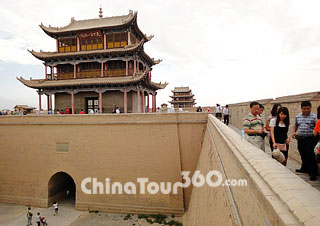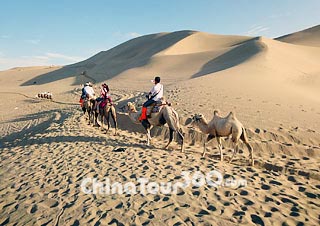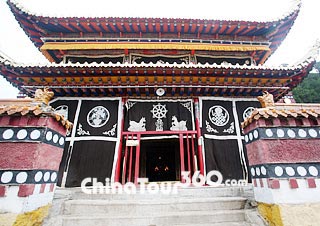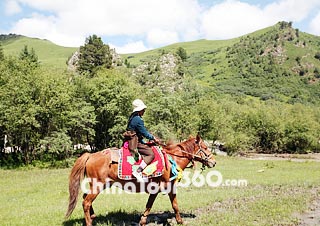 Jiayuguan Great Wall
Jiayuguan Great Wall Camel Tour in Dunhuang
Camel Tour in Dunhuang Tianshui Maijishan Grottoes
Tianshui Maijishan Grottoes Gannan Langmu Temple
Gannan Langmu Temple Gannan Zecha Stone Forest
Gannan Zecha Stone Forest Dunhuang Mogao Caves
Dunhuang Mogao Caves
Gansu province, Gan or Long for short, is located at the upper streams of the Yellow River, neighbouring Shaanxi, Sichuan, Qinghai, Xinjiang, Inner Mongolia and Ningxia. It has a total area of 453,700 square kilometers (175,174.5 square miles) and a population of 25,575,254 (2012 statistics). In ancient times, it was an important transit station on the Silk Road. Now more and more tourists go there to discover the past glory of the ancient Silk Road.
Lanzhou is the provincial capital of Gansu and was also an important transportation hub along the ancient Silk Road. The Yellow River traverses the city and divides it into two. Dunhuang is under the governance of Jiuquan City. It is also located on the Silk Road and was a busy trading port in ancient times. It is known to the world for the grottoes, murals and ancient great walls. Jiayuguan is the starting point of the Ming-dynasty Great Wall in China. The well-preserved fortress in the city is renowned as the No. 1 Pass under Heaven. Located in the center of Gansu, Wuwei named Liangzhou and was a significant communication hub along the Silk Road. It is the hometown of grape wine in China and also the world’s only habitat for white yaks. Xiahe is a county in the north of Gannan Tibetan Autonomous Prefecture. It is known as the Oriental Vatican because that Labrang Monastery - one of the six major temples of the Yellow Sect - is situated in the county. Located in the northwest of Gansu, Zhangye city has long been well-known for its long history of over 2,000 years, profound Silk Road culture, and picturesque scenery. Tianshui is the second largest cities in the province, stretching over the watersheds of both Yangtze and Yellow Rivers. It is the hometown of the famous Maiji Mountain Grottoes. Other cities in the province are Jinchang, Jiuquan, Pingliang and Baiyin.
![]() Attractions
Attractions
Mogao Grottoes, Echoing-sand Mountain, Crescent Lake, Dunhuang Museum
Gansu Great Wall: Jiayuguan Pass, Yumenguan Pass, Yanguan Pass, Dunhuang Great Wall, Overhanging Great Wall
Gansu province is located at the upper streams of the Yellow River, where is one of the birthplaces of Chinese culture. It is also one of the most important stations along the ancient Silk Road. Many historical relics can be found here. The most famous attraction in Gansu should be the Mogao Grottoes which are known to world for the exquisite murals and statues, as well as the profound Buddhism culture. One of China’s greatest constructions, the Great Wall also finds its traces in Gansu. The Dunhuang Great Wall and Yumen Pass, still stand in the desert after thousands of years, although only deserted earth mounds are left; it is hard to imagine them in the role of protection. There is also the famous Jiayuguan Pass, which is at the west end of the Great Wall in China and the best preserved of passes along the Chinese Great Wall.
Apart from these historical legacies, Gansu is also blessed with natural wonders. There is the gorgeous Danxia landform in Zhangye City, and the famous Crescent Lake and Echoing-sand Mountain in Dunhuang.
![]() Best Time to Visit
Best Time to Visit
The best time to visit Gansu is between May and October. However, the climate of northern Gansu is significantly different from that of the southern part due to their different location. The northern part, particularly the area north to Lanzhou, has a dry and windy spring, a hot summer and a cold winter. Thus summer and autumn are the best time to visit the area. Please note that the temperature changes a lot from morning to night in one day, so visitors may need to take a warm jacket even in hot summer.
The natural pasture is the major attraction in southern Gansu, so summer is the best time to see the verdant plants. Sun-glasses, hat and sun-tan lotion are the necessities, of course; however, a warm coat will also be useful in rainy days.
![]() Travel Tips
Travel Tips
1. When you are traveling in Gansu, please show your respect to local customs and lifestyles there.
2. In windy seasons, you need to protect your camera from sand and dust. Take a standby battery if you visit there in winter.
3. If you want to take pictures of monks, lamas, or people in minority costumes, you need to get their permission.
![]() Recommended Gansu Tour Itinerary:
Recommended Gansu Tour Itinerary:
China Silk Road Tour: 20 Days of Beijing - Xian - Xining - Lanzhou - Xiahe - Lanzhou - Wuwei - Zhangye - Jiayuguan - Dunhuang - Turpan - Urumqi – Shanghai







